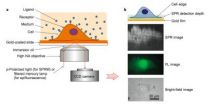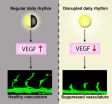(Press-News.org) Proteins adorning the surfaces of human cells perform an array of essential functions, including cell signaling, communication and the transport of vital substances into and out of cells. They are critical targets for drug delivery and many proteins are now being identified as disease biomarkers — early warning beacons announcing the pre-symptomatic presence of cancers and other diseases.
While study of the binding properties of membrane proteins is essential, detailed analysis of these complex entities is tricky. Now, Nongjian (NJ) Tao, Professor of Electrical Engineering, and director of the Center for Bioelectronics and Biosensors at Arizona State University's Biodesign Institute has devised a new technique for examining the binding kinetics of membrane proteins.
"This is a very important but very difficult problem to solve," Tao notes. "We demonstrate a new method of approaching the issue, which provides a quantitative analysis of protein interactions on the surface of a cell."
The technique — known as SPR microscopy — holds the potential to simplify the study of membrane proteins, thereby streamlining the development of new drugs, aiding the identification of diagnostic biomarkers and improving the understanding of cell-pathogen interactions.
The group's results appear in this week's advanced online issue of the journal Nature Chemistry.
Typically, proteins attached to or embedded in the cell membrane's lipid bilayer are either tagged with fluorescent markers or extracted from their locations, purified and immobilized on a glass surface in protein microarrays. These efforts may not accurately reflect native configuration and function.
Membrane proteins are complex structures whose subtle performance is often related to alterations in conformation and the particular binding kinetics at work. Existing techniques using florescent markers have been applied to pinpoint binding events, but these only permit the visualization of the protein before and after binding, omitting the dynamic processes evolving over time. Further, the use of fluorescent labels to tag protein molecules can interfere with the processes researchers hope to observe.
Alternately, proteins are extracted, purified and affixed to microarray slides — a labor-intensive process that removes proteins from their native environment, potentially affecting the shapes they naturally assume in situ and/or altering protein function.
In the current study, a label-free imaging technique is applied in situ to membrane proteins, which are visualized using a property known as surface plasmon resonance. This effect occurs when polarized light strikes the surface of a glass slide coated with a thin metallic film of gold. Under proper conditions of wavelength, polarization and incident angle, free electrons in the metal film absorb incident photons, converting them into plasmon waves, which propagate much like waves in water.
When nanoscale phenomena, including membrane proteins, interact and disrupt plasmon waves, they cause a measurable change in light reflectivity, which the new microscopy method converts into an image. (Figure 1a illustrates the basic setup of this technique.)
Surface plasmon resonance had already been applied to extracted proteins to study binding kinetics, though Tao explains that many steps are required and proteins may lose their proper conformational characteristics. This is particularly true for proteins normally embedded in a cell membrane's lipid matrix.
Another important consideration for the study of membrane proteins is the fact that that they arrange themselves heterogeneously across membrane surfaces and modify their distribution during various cellular activities. This behavior is particularly important during a process known as chemotaxis, when cells direct their movements under the influence of chemicals in the surrounding environment. For this reason, a tool allowing for both spatial and temporal study of membrane protein distribution in real time is highly desirable.
Tao's method uses surface plasmon resonance to provide high-resolution spatial and temporal information, and also allows for simultaneous optical and fluorescence observation of the sample, combining the advantages of both label-based and label-free methods.
High spatial resolution proved particularly useful for observing the ways polarized membrane proteins (bearing hydrophobic and hydrophilic regions) rearrange themselves, assisting cell migration directed by surrounding chemicals. The phenomenon also plays an important role during immune recognition. Using SPR microscopy, the spatial distribution of membrane proteins in single cells during chemotaxis could be mapped in detail for the first time, using a chemoattractant to induce cell migration.
Cells for study are cultured directly on a gold-coated slide, which can be subjected to simultaneous bright-field, florescent and SPR imaging. A liquid containing binding ligands is then applied over cells and the binding events with cell surface proteins monitored with SPR.
The technique permits millisecond resolution of temporal events and sub-micron scale analysis of spatial distribution. (See Figure 1b). In the current study, the method examined the binding of membrane glycoproteins with lectin ligands, the spatial distribution of membrane receptor molecules and membrane protein polarization and redistribution events.
The versatility of the new method, allowing for simultaneous imaging in optical, fluorescent and SPR modes, promises to significantly expand the study of membrane proteins in their native state, improving the understanding of protein binding kinetics and speeding the development of drugs targeting membrane proteins.
Tao stresses that such techniques — by more closely approximating in vivo conditions — provide a valuable window into biological processes relevant to health and disease: "Cells are different from tissues which are different from human beings, but at least now we can move from a system on the surface of a glass slide to an actual cell surface."
INFORMATION:
In addition to his appointment as the Director of the Center for Bioelectronics and Biosensors at the Biodesign Institute, Tao is Ira A. Fulton School of Engineering, School of Electrical, Computer and Energy Engineering.
Written by: Richard Harth
Science Writer: The Biodesign Institute
richard.harth@asu.edu
A new look at proteins in living cells
2012-08-28
ELSE PRESS RELEASES FROM THIS DATE:
Advanced CT scans accurately assess coronary blockages
2012-08-28
An ultra-fast, 320-detector computed tomography (CT) scanner can accurately sort out which people with chest pain need – or don't need – an invasive procedure such as cardiac angioplasty or bypass surgery to restore blood flow to the heart, according to an international study. Results of the study, which involved 381 patients at 16 hospitals in eight countries, are scheduled to be presented at the European Society of Cardiology Congress in Munich, Germany, on August 28.
"The CORE 320 study is the first prospective, multicenter study to examine the diagnostic accuracy ...
Better vaccines for tuberculosis could save millions of lives
2012-08-28
Cases of one of the world's deadliest diseases—tuberculosis—are rising at an alarming rate, despite widespread vaccination. Reasons for the ineffectiveness of the vaccine, especially in regions where this infectious disease is endemic, as well as arguments for replacing the existing vaccine with novel synthetic vaccines, are presented in a review published online August 28th in Trends in Molecular Medicine.
"Tuberculosis is a global health threat, and it is a highly communicable disease that may influence practically anyone and everyone," says senior author Javed Agrewala ...
CRT consensus set to standardize and improve care for patients worldwide
2012-08-28
Munich, Germany – August 28 2012: Recommendations for the practical management of CRT patients have been set out for the first time in an international consensus statement on cardiac resynchronization therapy (CRT) in heart failure.
The 2012 Expert Consensus Statement on Cardiac Resynchronization Therapy (CRT) in Heart Failure: Implant and Follow-up Recommendations and Management was developed by the European Heart Rhythm Association (EHRA), a registered branch of the European Society of Cardiology (ESC), and the Heart Rhythm Society (HRS) in the US, and will be published ...
PRAGUE-12 trial: Randomized open multicenter study
2012-08-28
Munich, Germany – August 28 2012: Surgical ablation of the left atrium to restore regular sinus rhythm is widely used in patients with atrial fibrillation (AF) undergoing cardiac surgery. The restoration of sinus rhythm might decrease the risk of heart failure, stroke and death during long-term follow up.(1) However, despite its promise, this theoretical benefit has never been clearly established - previous randomised studies have been small and performed in a selected group of patients undergoing mitral valve surgery.
Now, a multicentre study of surgical ablation (using ...
Omission of aspirin from antiplatelet regimen: The WOEST study
2012-08-28
Munich, Germany – August 28 2012: Lifelong anticoagulation is necessary for the prevention of stroke in patients with rhythm disturbances and with mechanical valves. Patients who have a coronary stent implanted also need the antiplatelet drugs aspirin and clopidogrel to prevent the rare but lethal complication of stent thrombosis. For patients taking oral anticoagulant drugs (for atrial fibrillation or mechanical valve) who also have to undergo coronary stenting, the optimal antithrombotic treatment is still unknown, even though the use of all three drugs (oral anticoagulants, ...
Catheter ablation for atrial fibrillation: Results from the first European registry
2012-08-28
Munich, Germany – August 28 2012: Catheter ablation for atrial fibrillation (Afib) is safe and suppresses arrhythmia recurrences in 74% of patients after a single procedure, according to results from the one-year follow-up of the Atrial Fibrillation Ablation Pilot Study, the first European registry to evaluate the real-life epidemiology of catheter ablation for AFib. The survey also showed that arrhythmia-related symptoms such as palpitations, shortness of breath, fatigue or dizziness - present in 86% of patients before the ablation - were significantly reduced.
The findings ...
CT angiography and perfusion to assess coronary artery disease: The CORE320 study
2012-08-28
Munich, Germany – August 28 2012: A non-invasive imaging strategy which integrates non-invasive CT angiography (CTA) and CT myocardial perfusion imaging (CTP) has robust diagnostic accuracy for identifying patients with flow-limiting coronary artery disease in need of myocardial revascularisation, according to results of the CORE320 study presented here today by Dr Joao AC Lima from Johns Hopkins Hospital, Baltimore, USA.
The CORE320 study is a prospective multicentre international trial which evaluated the diagnostic accuracy of combined non-invasive CTA and CTP as compared ...
Chinese scientists successfully crack the genome of diploid cotton
2012-08-28
August 28, 2012, Shenzhen, China – The international research team led by Chinese Academy of Agricultural Sciences and BGI have completed the genome sequence and analysis of a diploid cotton-- Gossypium raimondii. The cotton genome provides an invaluable resource for the study and genetic improvement of cotton quality and output, and sheds new lights on understanding the genetic characteristics and evolutionary mechanism underlying cotton and its close relatives. The study was published online in Nature Genetics. (http://www.nature.com/ng/journal/vaop/ncurrent/full/ng.2371.html).
Cotton, ...
The FAME 2 trial
2012-08-28
Munich, Germany – August 28 2012: Patients with stable coronary artery disease (CAD) had a lower need for urgent revascularisation when receiving fractional flow reserve (FFR)-guided PCI plus the best available medical therapy (MT) than when receiving MT alone. The results, from a final analysis of the FAME 2 trial, were presented today during a Hot Line session of ESC Congress 2012 in Munich. Treatment guided by fractional flow reserve assessment helped reduce the risk of urgent revascularisation by a factor of eight.
The FAME 2 (FFR-Guided Percutaneous Coronary Intervention ...
Zebrafish study explains why the circadian rhythm affects your health
2012-08-28
Disruptions to the circadian rhythm can affect the growth of blood vessels in the body, thus causing illnesses such as diabetes, obesity, and cancer, according to a new study from Linköping University and Karolinska Institutet in Sweden.
The circadian rhythm is regulated by a "clock" that reacts to both incoming light and genetic factors.
In an article now being published in the scientific journal Cell Reports, it is demonstrated for the first time that disruption of the circadian rhythm immediately inhibit blood vessel growth in zebra fish embryos.
Professor Yihai Cao ...

